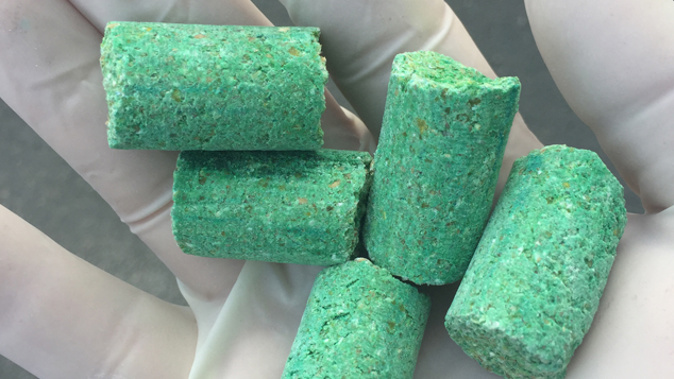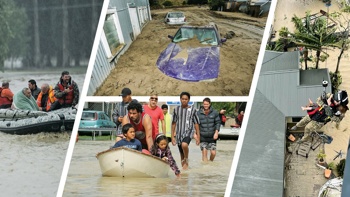
Auckland Council is rejecting claims it hasn't followed safety advice with its aerial drop of 1080 over the Hunua Ranges.
The council is waiting on a few days of consistently good weather before it drops a diluted form of the pesticide on the conservation site.
Most councillors support the measure as a way to control rat and possum numbers.
However, the drop has been met with some staunch opposition from some local residents.
More than 700 people have signed Hunua resident Angela Lloyd's petition asking for the 1080 drop to be cancelled.
She outlined her concerns in a statement read to councillors.
We put some of her concerns to the council, and compared their statements on particular issues.
1. Communication with renters
Angela Lloyd: "One neighbour was given a mask with no instructions as to how a carcass would retain the deadly poison, and the other neighbour with three registered dogs was not informed or supplied with masks. On contacting the council, she was told the landowner should have informed her. But many landowners of Auckland properties are now foreign and do not reside on site. Surely if your dog is registered and you live within one kilometre you should be notified."
Council spokesperson: "The Council has communicated directly with all residents bordering the operational area; this includes both landowners and occupiers. Following the public decision to change pest control methodology in the Hunua Ranges regional parklands we wrote to all residents neighbouring the operational area and asked them to complete a comprehensive questionnaire. The questionnaire asked them for information about the property including fencing, stock, domestic animals and water takes."
2. Communication with farmers
Angela Lloyd: "I have asked what compensation I will receive for relocating my horses to a safe facility and have received not answer."
Council spokesperson: "Adjoining landowners were offered the opportunity to meet directly with council representatives. In many cases, a staff member has visited properties to confirm operational boundaries; ensure fencing is in good order and talk through stock management; deliver emetics and muzzles and help with fitting muzzles for dogs; and generally discuss the operation."
3. Risk of contamination of private land
Angela Lloyd: "I am aware on several occasions 1080 has dropped outside the drop zone, resulting in the deaths of livestock on private property."
Council spokesperson: "Bait will only be applied to the Hunua Ranges regional parklands, adjoining DOC administered reserves and the private land whose owners have requested to be included in the operation. Sophisticated GPS technology ensures a high degree of accuracy, down to a matter of metres, for the bait application. Setbacks and exclusion zones along with the use of a trickle bucket to apply bait to sensitive areas will ensure that no areas will be treated unintentionally."
4. Risk of accidental contamination of private land
Angela Lloyd: "Clients are not prepared to risk breathing the dust that will be created by the drop while this operation is underway.."
Council spokesperson: "Our local regulations require a comprehensive operational plan and permission from the local public health authority. This is outlined in the National Pest Control Agency’s ‘Aerial 1080 Pest Control industry guidelines’. Good planning, use of highly accurate technology, good local knowledge, following best practice guidelines, strong communication and taking all necessary precautions will ensure there is no accidental application of 1080 baits, and will contribute to a successful operation."
5. Risk of contamination of private water supplies
Angela Lloyd: "Our cattle source water from the creek and river."
Council spokesperson: "We have been working with residents to understand private extraction of drinking water from streams flowing out of the operational area and have ensured the required exclusion zones have been applied around these water takes."
6. Risk of contamination to city water supplies
Angela Lloyd: "Chemicals often leach into the water tables and with the amount of springs in this area, this is inevitable."
Council spokesperson: "A precautionary approach is being taken to ensure the ongoing safety of Auckland’s public water supply including no flying over the water supply reservoirs, exclusion zones around the reservoirs where no bait is applied, disconnecting reservoirs from supply whilst treatment is underway and only returning reservoirs to service only after a rigorous water-testing schedule is complete and water meets the New Zealand Drinking Water Standards."
7. Accordance with manufacturer’s instructions
Angela Lloyd: "I am aware the manufacturers warn against aerial application and to keep it well away from waterways, insisting all carcasses should be removed to prevent contamination of the environment, and yet New Zealand uses 90 percent of 1080 produced and totally ignores these safety requirements."
Council spokesperson: "It’s important to note that the Tull Chemicals ‘manufacturer’s instructions’ apply to the pure toxic stock solution – that is 100 per cent 1080 toxin. This solution is then combined with cereal to create bait pellets used in aerial operations in New Zealand. Each pellet contains 0.15 per cent of the toxin."
8. Suitability for New Zealand
Angela Lloyd: "1080 is banned in most countries, and as more and more people see the results of its use, the opposition will grow."
Council spokesperson: "The manufacturer’s instructions are correct in saying that 1080 toxin is harmful to mammals and can cause secondary poisoning – which is the reason this toxin is deemed suitable for use in New Zealand, where our only native land mammals are bats, and we need a good tool for managing mammalian pests."
9. Muzzling of dogs
Angela Lloyd: "Our dog needs to be able to bark to be able to manage stock. How is this possible whilst wearing a mask?"
Council spokesperson: "Dogs are most at risk from 1080 poisoning due to their scavenging nature. For that reason we have provided considerable information to dog owners and offered emetic medication and muzzles to dog owners living adjacent to the operational area. Public information, signage and landowner visits have emphasised that dog owners need to be aware of the operation and risks, and in particular do not take animals into the operational area until a clearance is issued. The manufacturer’s instructions also recommend avoiding accidental application to waterways and compliance with local regulations."
10. Consideration of alternatives
Angela Lloyd: "There are alternatives. On behalf of over 600 people who have signed a petition we ask please withdraw your consent to drop this ultra-hazardous poison in our water catchment, because it puts our whole ecosystem at risk as it moves through the food chain."
Council spokesperson: "Possum and rat numbers have increased so significantly in the Hunua Ranges that the health of our forest and the threatened species, like kokako that live within it, are at risk. A ground-based pest control response would be almost impossible. In theory, it would require around 120,000 traps to target the range of pests in the Hunua Ranges alone – not to mention the DOC land or a response on neighbouring forested areas on private land. As well as being vast (the Hunua Ranges regional parklands is 17,000 hectares) the terrain in this area is steep and, in many places, inaccessible. The Hunua Ranges is free of kauri dieback disease, any intensive ground-based programme, particularly one that requires going off track and into kauri protection zones, would increase the risk of introducing kauri dieback."
Take your Radio, Podcasts and Music with you









